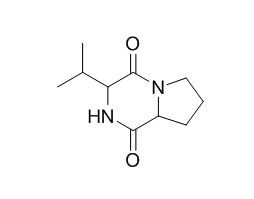Cyclo(Pro-Val)
Cyclo(Pro-Val) shows cyctoxic, moderate antifungal and weak antitumor activities in vitro, it can inhibit the growth of Bacillus subtilis with the minimal inhibitory concentration (MIC) value of 0.8 g/L. Cyclo(Pro-Val) and cyclo(Pro-Tyr) are toxic to both suspension cells and seedlings of Pinus thunbergii, which may offer some clues to research the mechanism of pine wilt disease caused by pine wood nematode.
Inquire / Order:
manager@chemfaces.com
Technical Inquiries:
service@chemfaces.com
Tel:
+86-27-84237783
Fax:
+86-27-84254680
Address:
1 Building, No. 83, CheCheng Rd., Wuhan Economic and Technological Development Zone, Wuhan, Hubei 430056, PRC
Providing storage is as stated on the product vial and the vial is kept tightly sealed, the product can be stored for up to
24 months(2-8C).
Wherever possible, you should prepare and use solutions on the same day. However, if you need to make up stock solutions in advance, we recommend that you store the solution as aliquots in tightly sealed vials at -20C. Generally, these will be useable for up to two weeks. Before use, and prior to opening the vial we recommend that you allow your product to equilibrate to room temperature for at least 1 hour.
Need more advice on solubility, usage and handling? Please email to: service@chemfaces.com
The packaging of the product may have turned upside down during transportation, resulting in the natural compounds adhering to the neck or cap of the vial. take the vial out of its packaging and gently shake to let the compounds fall to the bottom of the vial. for liquid products, centrifuge at 200-500 RPM to gather the liquid at the bottom of the vial. try to avoid loss or contamination during handling.
Int J Mol Sci.2022, 23(15):8687.
J Biol Chem.2021, 297(6):101362.
Nat Plants.2016, 3:16205
Biomed Sci Letters.2020, 26:319-326
Chengdu University of Traditional Chinese Medicine2024, 4802935.
Invest New Drugs.2017, 35(2):166-179
Ind. J. Pharm. Edu. Res.2023; 57(3):1132-1139.
Anal Chim Acta.2018, 1039:162-171
J Microbiol Biotechnol.2023, 33(10):1317-1328.
Front Pharmacol.2018, 9:236
Related and Featured Products
Journal of Shenyang Pharmaceutical University, 2007,24(8) :474-8.
Cyclic dipeptide constituents from the mangrove fungus Penicillium oxalicum(No.092007).[Reference:
WebLink]
To study the metabolites of mangrove fungus Penicillium oxalicum from the south China sea and search for new anti-tumor compounds.
METHODS AND RESULTS:
Compounds were isolated by silica gel,ODS column chromatography,Sephadex LH-20 column chromatography and reversed-phase HPLC purification.Structural elucidation was achieved by physico-chemical constants and spectroscopic analysis.MTT assay was used to evaluate the bioactivities in vitro. Six cyclic dipeptides were isolated from the acetone extracts of mycelium of fungus and elucidated as cyclo-(Phe-Ile)(1),cyclo-(Phe-Val)(3),cyclo-(Ile-Leu)(3),cyclo-(Val-Val)(4),Cyclo(Pro-Val)(5),cyclo-(Pro-Gly)(6).Coumpouds 2,3 and 5 could evidently inhibit the growth of cancer cell lines HepG Ⅱ and LNCaP at the concentration of 50 μg·mL-1.
CONCLUSIONS:
All of Compounds are obtained from the marine fungus for the fist time.Compounds 2,3 and 5 show cytotoxic activity in vitro.
Tetrahedron Lett.,2002, 33(51):6545-8.
Antifungal cyclopeptides from Halobacillus litoralis YS3106 of marine origin.[Reference:
WebLink]
METHODS AND RESULTS:
Three new cyclopeptides, including halolitoralin A (a cyclic hexapeptide), halolitoralin B and C (two cyclic tetrapeptides), together with three known cyclic dipeptides, Cyclo(Pro-Val), cyclo(Pro-Leu) and cyclo(Ile-Val) were isolated from the ferment broth of a marine sediment-derived Halobacillus litoralis YS3106.
CONCLUSIONS:
The cyclopeptides show surprisingly simple architectures with highly repeated residue units, which showed moderate antifungal and weak antitumor activities in vitro.
J Nematol. 2007 Sep;39(3):243-7.
Two Cyclic Dipeptides from Pseudomonas fluorescens GcM5-1A Carried by the Pine Wood Nematode and Their Toxicities to Japanese Black Pine Suspension Cells and Seedlings in vitro.[Pubmed:
19259494]
Pseudomonas fluorescens GcM5-1A, isolated from the pine wood nematode (PWN), Bursaphelenchus xylophilus, was cultured in Luria Broth medium (LB).
METHODS AND RESULTS:
The clarified culture was extracted with ethyl acetate, and two dipeptides were purified from the extract. The chemical structures of 1 and 2 were identified as Cyclo(Pro-Val)and cyclo(-Pro-Tyr-), respectively, by MS, (1)H NMR, (13)C NMR,(1)H-(1)H COSY, 1H -(13)C COSY spectra.
CONCLUSIONS:
Bioassay results showed that the two compounds were toxic to both suspension cells and seedlings of Pinus thunbergii, which may offer some clues to research the mechanism of pine wilt disease caused by PWN.



